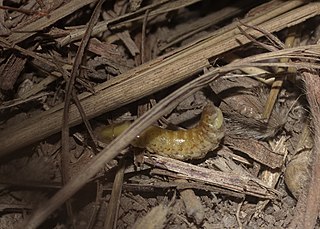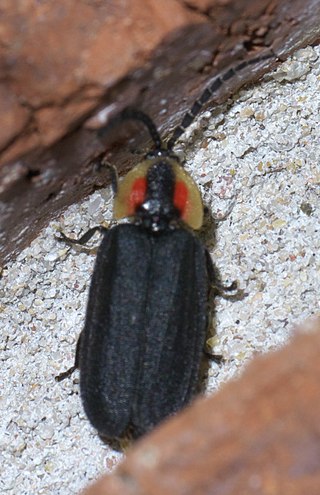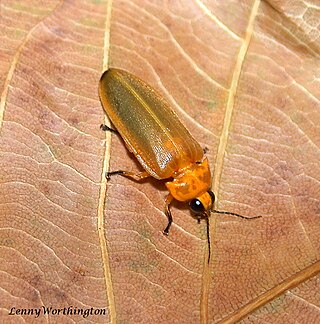
The Lampyridae are a family of elateroid beetles with more than 2,000 described species, many of which are light-emitting. They are soft-bodied beetles commonly called fireflies, lightning bugs, or glowworms for their conspicuous production of light, mainly during twilight, to attract mates. Light production in the Lampyridae is thought to have originated as an honest warning signal that the larvae were distasteful; this was co-opted as a mating signal in the adults. In a further development, female fireflies of the genus Photuris mimic the flash pattern of Photinus species to trap their males as prey.

Photuris is a genus of fireflies. These are the femme fatale lightning bugs of North America. This common name refers to a behavior of the adult females of these predatory beetles; they engage in aggressive mimicry, imitating the light signals of other firefly species' females to attract mates – but Photuris use it to attract, kill and eat the unsuspecting males of those other species. Their flashing bioluminescent signals seem to have evolved independently and eventually adapted to those of their prey, mainly unrelated Lampyrinae, such as Photinus or Pyractomena.
Glowworm or glow-worm is the common name for various groups of insect larvae and adult larviform females that glow through bioluminescence. They include the European common glow-worm and other members of the Lampyridae, but bioluminescence also occurs in the families Elateridae, Phengodidae and Rhagophthalmidae among beetles; as well as members of the genera Arachnocampa, Keroplatus and Orfelia among keroplatid fungus gnats.
Larviform female is a biological phenomenon occurring in some insect species, where the females in the adult stage of metamorphosis resemble the larvae to various degrees, while the male appears more morphologically adult. The resemblance may mean the larviform female has the same coloring as the larvae and/or similar body plans, and may be the result of the female arresting development at earlier stages of ecdysis than males. The female may not pupate at all, as in Xenos vesparum. Typically, the female is wingless and generally larger than the male. Larviform females still reach sexual maturity. Larviform females occur in several insect groups, including most Strepsiptera and Bagworm moths, many elateroid beetles, and some gall midges.

The Elateroidea are a large superfamily of beetles. It contains the familiar click beetles, fireflies, and soldier beetles and their relatives. It consists of about 25,000 species.

The Rhagophthalmidae are a family of beetles within the superfamily Elateroidea. Members of this beetle family have bioluminescent organs on the larvae, and sometimes adults, and are closely related to the Phengodidae, though historically they have been often treated as a subfamily of Lampyridae, or as related to that family. Some recent evidence suggested that they were the sister group to the Phengodidae, and somewhat distantly related to Lampyridae, whose sister taxon was Cantharidae, but more reliable genome-based phylogenetics placed as the sister group to the Lampyridae.
The Cratomorphini are a tribe of fireflies of the large subfamily Lampyrinae. The genera placed here often contain well-sized members of their family. The larvae of many species climb trees to feed on snails. This group contains a few "lightning bugs" from North America, e.g. the genus Pyractomena. Further south in the American tropics, Aspisoma can be found.
Atyphella is a genus of 'flashing' firefly found in the Australasian region, particularly in the eastern and northern regions of Australia. The genus consists of 23 recognized species, 14 considered to be endemic to Australia.
Brachylampis blaisdelli is a species of firefly in the family Lampyridae. It is found in North America.

Pyractomena is a genus of fireflies in the family Lampyridae. There are at least 20 described species in Pyractomena.

Aspisoma ignitum is a species of firefly in the family Lampyridae. It is found in the Caribbean, Central America, North America, and South America. Its presence is uncertain in the United States.

Aspisoma is a genus of fireflies in the family Lampyridae. There are at least 70 described species in Aspisoma.
Micronaspis is a genus of fireflies in the family of beetles known as Lampyridae, containing only one species, the Florida intertidal firefly. It is found in the Bahamas and Florida. It is threatened by habitat loss from coastal development as well as storm surges and sea level rise as a consequence of climate change, with Hurricane Dorian having a major impact on Grand Bahama island, where the species is known from. Increased chemical and light pollution has also seriously affected the species. Further threatening it in Florida is the introduction of Steinernema carpocapsae as a biocontrol agent for crops, which is known to target other beetle species than the ones it is meant to control; it is likely the cause of a local extirpation of a population of M. floridana from Sarasota Bay.

Lucidota atra, the black firefly or woodland lucy, is a diurnal species of firefly — a member of the Lampyridae family of beetles.

Pyractomena borealis commonly known as the spring tree-top flasher is a species of firefly in the beetle family Lampyridae. It is found in North America, where it has a very wide distribution, as it is known from Alberta east to the Maritime Provinces of Canada, and south to all US states east of the Mississippi River.

The Phengodes laticollis, is a species of the Glowworm Beetle within the family of Phengodidae. The name Phengodidae is the scientific name for a beetle in which their larvae are glowworms and are thus named for their bioluminescent qualities.

Pyractomena lucifera is a species of firefly in the beetle family Lampyridae. It is found in North America.
Paraphausis is a genus of fireflies in the family of beetles known as Lampyridae, containing a single described species, Paraphausis eximius.
Harmatelia bilinea, is a species of firefly beetle endemic to Sri Lanka.

Pteroptyx is a genus of fireflies in the subfamily Luciolinae found in Southeast Asia. It has long been noted for the ability to perform synchronous flashing, though not all species synchronize. These synchronizing species have been found on so-called 'firefly trees' and created a growing firefly-watching tour industry in some regions. Species of the genus have been identified in Malaysia, Thailand, the Philippines, and Hong Kong.










